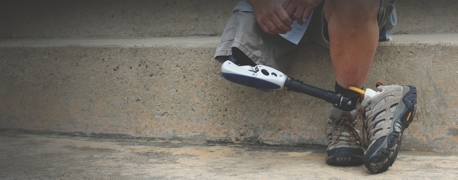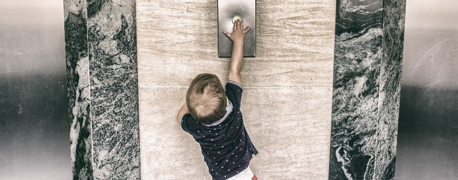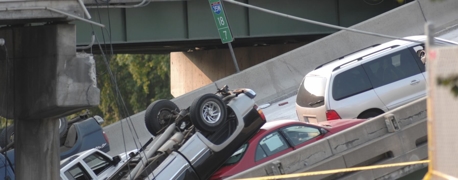Playground Safety Hazards & Solutions

Playgrounds are supposed to be areas where kids can be carefree as they enjoy some fun exercise, yet there are approximately 215,000 injuries sustained each year at public playgrounds, injuries that are severe enough to turn into an ER visit. According to the U.S. Consumer Protection Safety Commission (CPSC), there are more than 500 kids seriously hurt on playgrounds every single day and showing up at the emergency room. And every month in the U.S., at least one kid suffers a fatal and preventable accident on a playground.
Even so, there are no federal regulations for safe playground design and maintenance. The CPSC does have a handbook on public playground safety, but these are non-enforceable recommendations with safety information for the public. It is rare for states to have safety regulations for playgrounds, and even when they do exist, these regulations are often used by playground operators and equipment manufacturers to shield themselves from lawsuits. Throughout the nation, each county has different playground safety regulations, and even within county lines, cities will often have safety codes that differ from one another.
So how can you know if a playground is safe for kids, and what can you do if you find hazards?
Playground Safety Report Cards
While regulations for playgrounds are hyper-local, national organizations have put together helpful guidelines on playground safety. One such set of guidelines includes the “Daily Dozen” checklist written by the National Recreation and Park Association (NRPA).
Their checklist of playground safety covers:
- Temperature-safe and cushiony surfaces
- ADA compliance
- Ease of supervision
- Age-appropriate equipment
- Proper equipment (e.g., no trampolines)
- Sufficient space
- No impact and entanglement hazards
- No entrapment risks
- No trip hazards
- Rounded, not sharp edges
- Adequate maintenance
- Certified inspections
The National Program for Play Area Safety (NPPAS) also has a rubric for grading playground safety based on the playground’s location, design, fall protections, and maintenance.
According to the NPPAS, the most important requirements for a playground to be free of serious injury risks include:
- A playground site that is safe from motor vehicles and any motorized equipment.
- Equipment design that doesn’t let kids climb on the exterior of a structure.
- Safe surfacing that doesn’t have uncovered concrete to fall on.
- Fill material that is loose and deep enough in fall areas.
- Equipment that doesn’t have entrapment or strangulation hazards.
Too often, it takes a tragic playground accident before anyone takes equipment or design problems seriously. However, with these guidelines, parents can proactively look for risks and act accordingly.
Combining the guidelines from the CPSC, NRPA, and NPPAS, we’ll take a closer look at some of these major requirements for a safe playground.
Safety Hazards to Look Out for at Your Local Playground
First of all, the CPSC defines public playgrounds as more than those that are found at public parks.
They also include playgrounds at:
- Daycares
- Apartment and condo complexes
- Restaurants
- Schoolyards
- And many other sites that are accessible to the public
If you see any safety issues at these or similar sites, you are well within your rights to bring these issues up to whoever is responsible for the play area.
Surfacing & Surface Area
There are always going to be places around a playground where kids can fall. That doesn’t always mean that there are unaddressed hazards at that play site. However, if a fall zone has buried foundations that could cause blunt force trauma, that is a built-in hazard.
Surface materials that are hazardous in potential fall areas include:
- Concrete
- Asphalt
- Packed dirt
- Grass
- Carpet
- CCA-treated wood mulch
What is CCA-treated wood? This is wood that was treated with chromated copper arsenate, which has arsenic, chromium, and copper! Installing this CCA-treated wood stopped in the 1970s and 1980s, but it may still be in use at some older parks.
Surface materials that are generally safer for areas where kids can fall from a height include adequate depths of sand, pea gravel, shredded rubber, safety-tested rubber mats, engineered wood fiber, regular wood mulch, and wood chips. Loose-fill material like pea gravel is not considered enough of a cushion on its own if concrete or other hard surfaces are right beneath it though. For adequate protection, some loose-fill should be followed up by a layer of Geotextile cloth before adding more loose-fill material. Additional mats under places like slide openings and swings are also recommended.
As for the dimensions, you want the surface material of the playground to reach at least six feet out beyond the equipment in every direction, again so kids won’t fall on something dangerously hard. The surface material needs to extend the length of any slides and then four feet beyond the slide openings, and twice the height of a swing set, at both the front and the back.
Impact from falls is not the only concern when it comes to playground surfacing; overheating and burn risks are also a problem with certain surfaces, such as asphalt, or even metallic equipment.
Proper drainage and a site free of trip hazards are also critical when it comes to surfacing.
Trip Hazards
Some objects are poorly placed and can be a trip hazard for children. This can include exposed footings, electrical wires, or other obstacles in the environment, like tree roots.
Sudden shifts in elevation are also a safety risk in play areas. Bolts and anchoring devices for a playground should not stick out but should be installed underneath the surface material. Containment walls, such as for sandboxes, need to be easy to spot.
Equipment Selection
Even if playground equipment is well-designed, there are some types of equipment that experts recommend against ever installing in a public playground.
This unsafe equipment for a public playground includes:
- Trampolines
- Free swinging ropes
- Trapeze bars
- Heavy metal swings (including metal animals)
- Swinging gates
- Giant strides
- Climbing ropes that aren’t secured at both the top and bottom
Certain equipment is not age-appropriate either. For instance, if a daycare facility only supervises kids who are five and younger, it would automatically be a safety issue if the playground equipment for that facility included chain walks, seesaws, spiral slides with more than one 360° turn, and vertical slide poles—all meant for older children.
Safe Design & Condition of Playground Equipment
While we can’t exhaustively cover all the potential design flaws in playground equipment, many of them deal with potential entanglement risks, such as certain handholds and rungs. Other pieces of hardware like bolts, or splinters, nails, and broken equipment can protrude and present an impaling risk. Sometimes it’s a matter of faulty design, in others, a case of poor maintenance.
Gaps in a slide area or elevated walkway, for example, could snag a kid’s clothes or a limb. In general, there should be no gaps (ladder rungs included) that are between 3.5 and 9 inches wide. If gaps are smaller or greater than those parameters, that can eliminate head and neck entrapment risks.
If a kid rides a bike to the park, they should remove their helmet before running onto the playground equipment—the helmet could increase risks of their head or neck getting trapped.
Some other equipment hazards include:
- Broken, jagged, missing, or otherwise damaged structures
- Chipped or peeling paint (small kids can pop these in their mouths)
- Exposed electrical wires inside or near the play area
- Metal animals and objects on springs (the source of many impact and fall injuries)
- Unstable equipment that can be tipped over
For example, swing sets need to be made of solid materials, heavy wood or metal that will stand rigid, with seats of rubber or canvas. If the foundations of a slide, monkey bars, or swing set are loose and movable, that is a red flag that the equipment is not stable or rooted down well.
Ease of Supervision
There should be clear lines of sight for parents or other caregivers and supervisors to keep an eye on kids, whatever activity the kids choose. As needed, there should also be clear signage throughout the play area for supervisors to see.
Trees Near Play Areas
Trees can be very important to have near a playground, as consistent shade is another key aspect of safe playgrounds. There usually needs to be enough shade for equipment to not overheat, preventing burn injury risks, and children themselves need to be protected from sunburn hazards.
However, poor maintenance can mean that these trees are hazards themselves. Diseased, dying, and dead trees mean that branches and limbs can suddenly fall and land on unsuspecting children. Falling limbs have injured and killed toddlers in play areas.
Local municipalities are responsible for tree health in public spaces, and there are almost always ample warnings before a limb drops down onto someone. If a tree or any of its limbs look like it’s going to drop, or it’s encroaching onto play areas and is already a hazard, the owner/operator or city are probably falling behind on their maintenance. You can trust your instincts that that tree needs to be dealt with, and you can report this to whoever is responsible for it. Depending on your city, this could mean contacting city hall, submitting a service request with an urban forestry office, calling the HOA, etc.
ADA Requirements for Playgrounds
While there are no federal regulations for safety on playgrounds, there are federal regulations on accessibility that apply to newly built play areas and any alterations made to existing play areas.
At sites where these guidelines apply, accessible routes are key to being compliant. This means ramps, platforms, and lifts in the play area as needed, and, leading up to the play area, the presence of curb ramps, crosswalks, etc.
For instance, at each type of ground-level play, there has to be at least one accessible route. So at least one swing on a swing set must have an accessible route, and 50% of elevated components must have an accessible route, such as a ramp or transfer system. Elevated play components include slides, monkey bars, climbers, etc.
There are also specifications on how much space must be available on platforms and entry points so that key areas are wheelchair-accessible, and a child with mobility devices has the room to maneuver on ground levels and on platforms. Elevated play components must also have handrails at accessible heights, typically no more than 20 to 28 inches above the ramp. In transfer systems, handgrips and handholds need to be supplied.
Playground Safety Inspections
By enlisting an inspector, you can give yourself peace of mind and help whichever parties are responsible for the play area to abide by recognized safety guidelines. Or you can find out if the owner/operator maintains a regular inspection and maintenance schedule.
While all the previous information introduces some general playground safety standards, a Certified Playground Safety Inspector (CPSI) will be up to date on all the latest guidelines. CPSIs must re-up their certification every 3 years with the National Recreation and Park Association. This certification is available for a wide range of professionals, from parks and rec personnel and childcare professionals to landscapers, HOAs, contractors, and many others. But anyone over the age of 18 may be eligible to take the CPSI exam.
Unless this certification aligns with your career somehow, you probably don’t need to get certified yourself. Instead, you can take playground safety into your own hands by finding a local expert on the CPSI registry and contacting them to ensure the safety of your playground. An experienced and insured inspector can then survey the playground, write up a thorough report with pictures, and explain exactly what the owner/operator can do to improve safety and resolve hazards.
Or you can personally, unofficially inspect a playground and directly contact the owner/operator of the playground. You can tell them about the hazards you spotted and request that they deal with them before they turn into an accident. If something seems off or risky, you can trust your instincts and act on them.
Who Is Responsible for an Unsafe Playground?
Depending on the location of the playground, the party at fault for a playground accident could include the:
- Daycare owner/operator
- Homeowners’ association
- Municipality
- Parks and rec center
- Equipment manufacturer
- Contractor who built the playground
- Company/staff responsible for playground maintenance
- Person supervising the child at the time of the accident
While property owners and facility personnel typically want to avoid liability, the fact remains that too many owners and cities don’t intervene with playground hazards until a tragedy occurs, and only then when people start to raise their voices and file personal injury lawsuits.
Whether it’s poorly designed elements, ailing trees, or rundown playground equipment, you and your kids deserve better. It shouldn’t have to fall to you to make sure a public play area is safe for your kids, but if it seems to you that the parties responsible are failing to eliminate hazards in such a playground, you can act on your instincts. There are playground experts, legal professionals, and families around the country who are already working to create awareness and enforce safety measures for playgrounds everywhere. You can—and deserve to—be carefree when your child is at play.
- Categories


